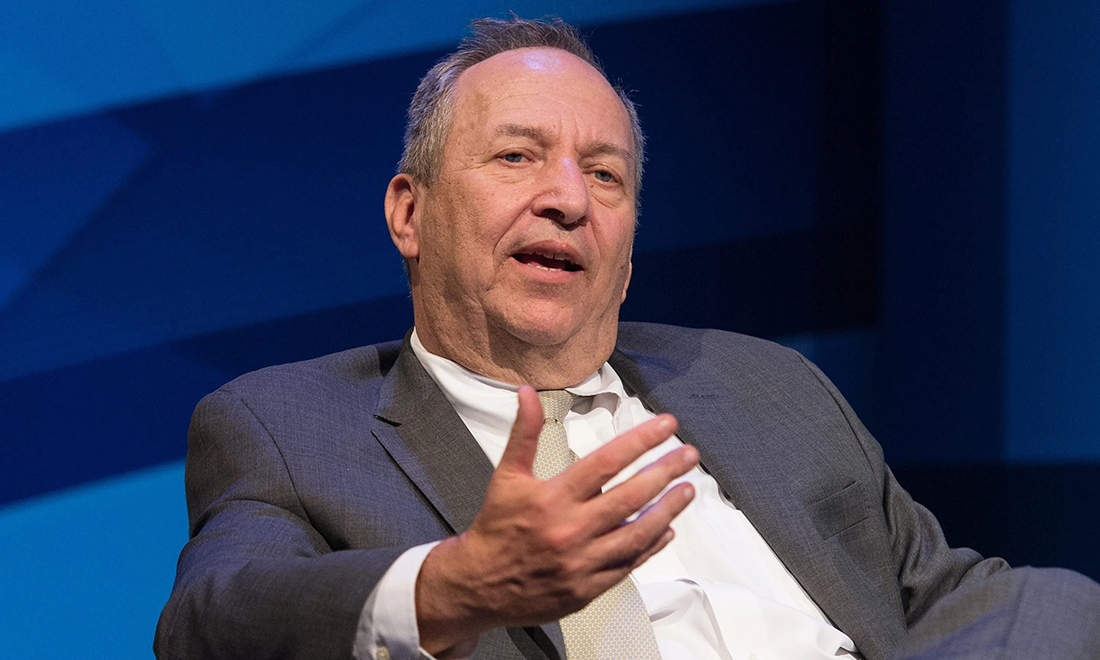
2022年,关于美国经济衰退的警告不绝于耳,而唯一令美国银行(Bank of America)的首席执行官布莱恩·莫伊尼汉等人安心的是,美国人没有停止消费。得益于美国人在新冠疫情期间积攒的2.5万亿美元过剩储蓄,美国的高消费性支出避免了严重的经济下行,但这个缓冲正在快速消失,而美国经济也因此濒临衰退边缘。
通货膨胀可能继续升高,导致强劲的消费性支出没有保证,如果美国人减少消费,美国经济就可能出现一种截然不同的状况。经济学家、美国财政部前部长拉里·萨默斯认为,经济衰退的时刻可能比你想象的时间更早来临。
萨默斯于3月6日在接受美国有线电视新闻网(CNN)的主持人波比·哈洛采访时说:“我预测,消费者积攒的过度储蓄,还能够维持几个月的消费,但高消费的势头不可能再持续一年。”
萨默斯认为,美国经济可能正在接近“大笨狼怀尔时刻”。大笨狼怀尔是动画片《乐一通》(Looney Toons)中的角色,它总是在追逐灵活的哔哔鸟,在跑过悬崖边缘之后才意识到问题,然后开始跌落。
萨默斯指出,美国经济可能出现同样的情形;它可能跌落悬崖;随着消费减少,将没有任何力量可以阻止美国经济跌落低谷。
他表示:“我一直用‘大笨狼怀尔时刻的风险’,来形容美国经济可能在几个月内陷入衰退。”
经济缓冲
几个月来,对于美国经济避免衰退的可能性,萨默斯基本上持悲观的态度。虽然包括诺贝尔奖(Nobel Prize)的得主保罗·克鲁格曼在内的许多知名经济学家认为,积极的通货膨胀数据表明美国经济有可能实现软着陆,但萨默斯依旧警告,美国发生经济衰退的“概率更高”。
在2022年的最后几个月,经济学家们有合理的理由感到乐观,而高消费性支出是主要原因之一。到目前为止的几个月,虽然通货膨胀持续上升,但消费一直在稳步增长。新冠疫情初期,美国家庭进行大量商品消费,但限制社交距离的封锁措施却增加了美国家庭的储蓄。据美国商务部(Commerce Department)统计,最近几个月,消费屡创新高,1月增长了1.8%。美国人终于开始服务消费,想找工作的人大都得偿所愿,而且工资也有所上涨,这些因素都促进了消费增长。
但这并不意味着消费会持续强劲。美国人大肆消费的主要资金来源是新冠疫情期间的储蓄,而这个来源可能在几个月前就开始枯竭。
据西北互助保险公司(Northwestern Mutual)统计,美国人存入储蓄账户的税后收入比重从2021年12月的8.4%下降到2022年3月的6.2%。2022年12月,美国人的个人储蓄率降至接近史上最低点。
2022年7月,穆迪分析(Moody’s Analytics)的首席经济学家马克·赞迪预测,美国低收入群体的储蓄可能在六个月内耗尽,而富裕家庭储蓄耗尽的时间也不会太久。如今已经过了赞迪预测的期限,许多美国人可能已经用光了大多数储蓄,因为Bankrate的高级行业分析师特德·罗斯曼在今年2月对《财富》杂志表示,美国信用卡持卡人有信用卡欠款的比例从一年前的39%增加到目前的46%。
由于消费性支出占美国GDP的70%左右,因此这意味着美国人避免经济增速下滑甚至经济衰退的缓冲越来越少。而事实证明,与几个月前经济学家们的预测相比,通货膨胀显然更加顽固,难以抑制,因此消费性支出下降可能恰逢一个最糟糕的时期。
萨默斯告诉美国有线电视新闻网:“波比,我认为,毫无疑问,我们并没有使通货膨胀进入下降到接近2%的安全下行轨道。”他表示,除非美联储(Federal Reserve)确信通货膨胀将稳定下降到正常水平,否则利率就会持续上涨,导致借款成本增加,可能使消费者选择储蓄而不是消费。
萨默斯说:“我预测,降低通货膨胀的过程会在某个阶段引发经济衰退,就像以前几乎总是会发生的状况一样。在通货膨胀的风险和经济衰退的风险之间,美联储试图在一条狭窄的岩架上行走,这种局面很难应对。”(财富中文网)
译者:刘进龙
审校:汪皓
2022年,关于美国经济衰退的警告不绝于耳,而唯一令美国银行(Bank of America)的首席执行官布莱恩·莫伊尼汉等人安心的是,美国人没有停止消费。得益于美国人在新冠疫情期间积攒的2.5万亿美元过剩储蓄,美国的高消费性支出避免了严重的经济下行,但这个缓冲正在快速消失,而美国经济也因此濒临衰退边缘。
通货膨胀可能继续升高,导致强劲的消费性支出没有保证,如果美国人减少消费,美国经济就可能出现一种截然不同的状况。经济学家、美国财政部前部长拉里·萨默斯认为,经济衰退的时刻可能比你想象的时间更早来临。
萨默斯于3月6日在接受美国有线电视新闻网(CNN)的主持人波比·哈洛采访时说:“我预测,消费者积攒的过度储蓄,还能够维持几个月的消费,但高消费的势头不可能再持续一年。”
萨默斯认为,美国经济可能正在接近“大笨狼怀尔时刻”。大笨狼怀尔是动画片《乐一通》(Looney Toons)中的角色,它总是在追逐灵活的哔哔鸟,在跑过悬崖边缘之后才意识到问题,然后开始跌落。
萨默斯指出,美国经济可能出现同样的情形;它可能跌落悬崖;随着消费减少,将没有任何力量可以阻止美国经济跌落低谷。
他表示:“我一直用‘大笨狼怀尔时刻的风险’,来形容美国经济可能在几个月内陷入衰退。”
经济缓冲
几个月来,对于美国经济避免衰退的可能性,萨默斯基本上持悲观的态度。虽然包括诺贝尔奖(Nobel Prize)的得主保罗·克鲁格曼在内的许多知名经济学家认为,积极的通货膨胀数据表明美国经济有可能实现软着陆,但萨默斯依旧警告,美国发生经济衰退的“概率更高”。
在2022年的最后几个月,经济学家们有合理的理由感到乐观,而高消费性支出是主要原因之一。到目前为止的几个月,虽然通货膨胀持续上升,但消费一直在稳步增长。新冠疫情初期,美国家庭进行大量商品消费,但限制社交距离的封锁措施却增加了美国家庭的储蓄。据美国商务部(Commerce Department)统计,最近几个月,消费屡创新高,1月增长了1.8%。美国人终于开始服务消费,想找工作的人大都得偿所愿,而且工资也有所上涨,这些因素都促进了消费增长。
但这并不意味着消费会持续强劲。美国人大肆消费的主要资金来源是新冠疫情期间的储蓄,而这个来源可能在几个月前就开始枯竭。
据西北互助保险公司(Northwestern Mutual)统计,美国人存入储蓄账户的税后收入比重从2021年12月的8.4%下降到2022年3月的6.2%。2022年12月,美国人的个人储蓄率降至接近史上最低点。
2022年7月,穆迪分析(Moody’s Analytics)的首席经济学家马克·赞迪预测,美国低收入群体的储蓄可能在六个月内耗尽,而富裕家庭储蓄耗尽的时间也不会太久。如今已经过了赞迪预测的期限,许多美国人可能已经用光了大多数储蓄,因为Bankrate的高级行业分析师特德·罗斯曼在今年2月对《财富》杂志表示,美国信用卡持卡人有信用卡欠款的比例从一年前的39%增加到目前的46%。
由于消费性支出占美国GDP的70%左右,因此这意味着美国人避免经济增速下滑甚至经济衰退的缓冲越来越少。而事实证明,与几个月前经济学家们的预测相比,通货膨胀显然更加顽固,难以抑制,因此消费性支出下降可能恰逢一个最糟糕的时期。
萨默斯告诉美国有线电视新闻网:“波比,我认为,毫无疑问,我们并没有使通货膨胀进入下降到接近2%的安全下行轨道。”他表示,除非美联储(Federal Reserve)确信通货膨胀将稳定下降到正常水平,否则利率就会持续上涨,导致借款成本增加,可能使消费者选择储蓄而不是消费。
萨默斯说:“我预测,降低通货膨胀的过程会在某个阶段引发经济衰退,就像以前几乎总是会发生的状况一样。在通货膨胀的风险和经济衰退的风险之间,美联储试图在一条狭窄的岩架上行走,这种局面很难应对。”(财富中文网)
译者:刘进龙
审校:汪皓
When recession warnings hit a fever pitch last year, the only thing reassuring people like Bank of America CEO Brian Moynihan was that Americans were still spending. High U.S. consumer spending, thanks to $2.5 trillion in excess savings accumulated during the pandemic, has helped guard against a severe economic downturn, but that buffer is vanishing fast, and the economy could be on the verge of a recession because of it.
With inflation at risk of rising more, strong consumer spending is no guarantee, and the economy would look very different if Americans slow their purchases. That moment may be closer than you think, according to economist and former Treasury Secretary Larry Summers.
“My guess is that the overhang, the savings that consumers have accumulated, has a few more months to run, but it doesn’t have another year to run,” Summers told CNN’s Poppy Harlow in an interview on March 6.
Summers said the economy could be nearing a “Wile E. Coyote moment,” a reference to the Looney Toons character with a tendency to chase an elusive Road Runner off the edge of a cliff, when it eventually realizes its mistake and starts falling.
The same thing could be happening to the U.S. economy, Summers said; it could be running off a cliff edge, and once spending runs dry, there’ll be nothing to stop it from plunging to the bottom.
“I’ve used the term ‘Risk of a Wile E. Coyote moment’ to refer to the fact that the economy could hit an air pocket in a few months,” he said.
The economy’s buffer
For months, Summers has been largely pessimistic on the U.S. economy’s chances of avoiding a recession. Even when notable economists including Nobel Prize–winning Paul Krugman pointed to positive inflation data as reason to believe a soft landing was possible if not likely, Summers still warned that a recession was “more likely than not.”
Economists had good reasons to be optimistic in the last few months of 2022, and high consumer spending was a big part of that. Spending has been floating along at steady levels for months now despite rising inflation. Households spent large amounts on goods in the early days of the pandemic, but saved even more due to lockdowns on distancing restrictions. Spending hit new heights in recent months, increasing 1.8% in January, according to the Commerce Department. It’s helped by the fact that Americans are finally spending money on services again, most people who want a job have one, and wages are rising.
But that doesn’t mean spending will stay strong forever. The main source of Americans’ profligacy, their pandemic savings, may have started running dry months ago.
The share of after-tax income Americans put into their savings accounts dropped from 8.4% in December 2021 to 6.2% in March 2022, according to Northwestern Mutual. In December, Americans’ personal savings rate dropped to near its all-time low.
In July, Moody’s Analytics chief economist Mark Zandi predicted that savings for low-income Americans could start running out within six months, with wealthier households not far behind. That timeline has now passed, and many Americans may have already exhausted most of their savings, as the number of credit card holders with credit card debt is now 46%, up from 39% a year ago, Ted Rossman, senior industry analyst at Bankrate, told Fortune in February.
Since consumer spending accounts for around 70% of U.S. GDP, it all adds up to a thinner buffer zone for Americans to avoid a slowdown in economic growth and a recession. But with inflation proving more stubborn to bring down than some economists predicted only a few months ago, consumer spending may be drying up at the worst possible time.
“I don’t think there’s any question, Poppy, that we do not yet have inflation on a secure glide path anyway near down to the 2% level,” Summers told CNN. He added that until the Federal Reserve is confident inflation is on a stable path to normalcy, interest rates will keep rising, making borrowing more expensive and potentially pushing consumers to save rather than spend.
“My guess is that the process of bringing down inflation will bring on a recession at some stage as it almost always has in the past,” Summers said. “Between the risk of inflation and the risk of some kind of air pocket, the Fed is trying to walk along a very, very narrow ledge, and it’s not a very easy situation.”






